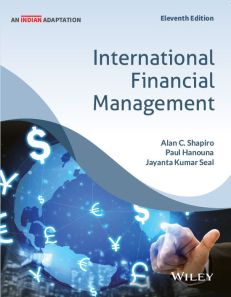International Financial Management, 11ed (An Indian Adaptation)
ISBN: 9789357460880
676 pages
For more information write to us at: acadmktg@wiley.com

Description
International Financial Management, 11th Edition is a comprehensive survey of the essential areas of the international financial market environment, including foreign exchange and derivative markets, risk management, and international capital markets and portfolio investment. Designed for upper-level undergraduate and masters-level courses in international finance and management, this textbook offers readers a conceptual framework for analyzing key financial decisions of multinational firms. The authors both explain and simplify multinational financial management by illustrating how its basic principles share the same foundation as domestic corporate finance.
Part I The International Financial Management Environment
1 Introduction: Multinational Corporations and Financial Management
1.1 The Rise of The Multinational Corporation
1.2 The Internationalization of Business and Finance
1.3 Multinational Financial Management: Theory and Practice
1.4 Outline of The Book
2 The Determination of Exchange Rates
2.1 Setting the Equilibrium Spot Exchange Rate
2.2 Expectations and The Asset Market Model of Exchange Rates
2.3 The Fundamentals of Central Bank Intervention
2.4 The Equilibrium Approach to Exchange Rates
2.5 Disequilibrium Theory and Exchange Rate Overshooting
2.6 Conclusions
3 The International Monetary System
3.1 Alternative Exchange Rate Systems
3.2 A Brief History of The International Monetary System
3.3 The European Monetary System and Monetary Union
3.4 Emerging Market Currency Crises
3.5 Summary and Conclusions
4 Parity Conditions in International Finance and Currency Forecasting
4.1 Arbitrage and The Law of One Price
4.2 Purchasing Power Parity
4.3 The Fisher Effect
4.4 The International Fisher Effect
4.5 Interest Rate Parity Theory
4.6 The Relationship Between the Forward Rate and The Future Spot Rate
4.7 Currency Forecasting
4.8 Summary and Conclusions
5 The Balance-of-Payments and International Economic Linkages
5.1 Balance-Of-Payments Categories
5.2 The International Flow of Goods, Services, And Capital
5.3 Coping with The Current-Account Deficit
5.4 Summary and Conclusions
Part II The Foreign Exchange and Derivative Markets
6 The Foreign Exchange Market
6.1 The Foreign Exchange Market: A Snapshot
6.2 Organization of The Foreign Exchange Market
6.3 The Spot Market
6.4 The Forward Market
6.5 Summary and Conclusions
7 Currency Futures and Options Markets
7.1 Futures Contracts
7.2 Currency Options
7.3 Reading Currency Futures and Options Prices
7.4 Summary and Conclusions
8 Currency, Interest Rate, and Credit Derivatives and Swaps
8.1 Interest Rate and Currency Swaps
8.2 Interest Rate Forwards and Futures
8.3 Structured Notes
8.4 Credit Default Swaps
8.5 Summary and Conclusions
Part III Foreign Exchange Risk Management
9 Measuring and Managing Translation and Transaction Exposure
9.1 Alternative Measures of Foreign Exchange Exposure
9.2 Alternative Currency Translation Methods
9.3 Transaction Exposure
9.4 Designing A Hedging Strategy
9.5 Managing Translation Exposure
9.6 Managing Transaction Exposure
9.7 Summary and Conclusions
10 Measuring and Managing Economic Exposure
10.1 Foreign Exchange Risk and Economic Exposure
10.2 The Economic Consequences of Exchange Rate Changes
10.3 Identifying Economic Exposure
10.4 Calculating Economic Exposure
10.5 An Operational Measure of Exchange Risk
10.6 Managing Operating Exposure
10.7 Summary and Conclusions
Part IV The International Capital Markets and Portfolio Management
11 International Financing and National Capital Markets
11.1 Corporate Sources and Uses of Funds
11.2 National Capital Markets as International Financial Centers
11.3 Development Banks
11.4 Project Finance
11.5 Summary and Conclusions
12 The Euromarkets
12.1 The Eurocurrency Market
12.2 Eurobonds
12.3 Note Issuance Facilities and Euronotes
12.4 Euro-Commercial Paper
12.5 The Asia currency Market
12.6 External Commercial Borrowings (ECB)
12.7 Masala Bonds
12.8 Summary and Conclusions
13 International Portfolio Management
13.1 The Risks and Benefits of International Equity Investing
13.2 International Bond Investing
13.3 Optimal International Asset Allocation
13.4 Measuring the Total Return from Foreign Portfolio Investing
13.5 Measuring Exchange Risk on Foreign Securities
13.6 Summary and Conclusions
Part V International Capital Budgeting
14 Country Risk Analysis
14.1 Measuring Political Risk
14.2 Economic and Political Factors Underlying Country Risk
14.3 Country Risk Analysis in International Lending
14.4 Summary and Conclusions
15 The Cost of Capital for Foreign Investments
15.1 The Cost of Equity Capital
15.2 The Weighted Average Cost of Capital for Foreign Projects
15.3 Discount Rates for Foreign Investments
15.4 The Cost of Debt Capital
15.5 Establishing A Worldwide Capital Structure
15.6 Valuing Low-Cost Financing Opportunities
15.7 Summary and Conclusions
16 Corporate Strategy and Foreign Direct Investment
16.1 Theory of The Multinational Corporation
16.2 Designing A Global Expansion Strategy
16.3 Foreign Direct Investment in India
16.4 Participatory Notes
16.5 Summary and Conclusions
17 Capital Budgeting for the Multinational Corporation
17.1 Basics of Capital Budgeting
17.2 Issues in Foreign Investment Analysis
17.3 Foreign Project Appraisal: The Case of International Diesel Corporation
17.4 Political Risk Analysis
17.5 Growth Options and Project Evaluation
17.6 Summary and Conclusions
18 Managing the Internal Capital Markets of Multinational Corporations
18.1 The Value of The Multinational Financial System
18.2 Intercompany Fund-Flow Mechanisms: Costs and Benefits
18.3 Designing A Global Remittance Policy
18.4 Summary and Conclusions
Questions
Problems
Further Readings

